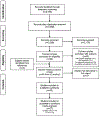Long-Acting Reversible Contraception, Condom Use, and Sexually Transmitted Infections: A Systematic Review and Meta-analysis
- PMID: 34686301
- PMCID: PMC9125421
- DOI: 10.1016/j.amepre.2021.04.032
Long-Acting Reversible Contraception, Condom Use, and Sexually Transmitted Infections: A Systematic Review and Meta-analysis
Abstract
Introduction: Given mixed findings regarding the relationship between long-acting reversible contraception and condom use, this systematic review and meta-analysis synthesizes studies comparing sexually transmitted infection‒related outcomes between users of long-acting reversible contraception (intrauterine devices, implants) and users of moderately effective contraceptive methods (oral contraceptives, injectables, patches, rings).
Methods: MEDLINE, Embase, PsycINFO, Global Health, CINAHL, Cochrane Library, and Scopus were searched for articles published between January 1990 and July 2018. Eligible studies included those that (1) were published in the English language, (2) were published in a peer-reviewed journal, (3) reported empirical, quantitative analyses, and (4) compared at least 1 outcome of interest (condom use, sexual behaviors other than condom use, sexually transmitted infection‒related service receipt, or sexually transmitted infections/HIV) between users of long-acting reversible contraception and users of moderately effective methods. In 2020, pooled ORs were calculated for condom use, chlamydia/gonorrhea infection, and trichomoniasis infection; findings for other outcomes were synthesized qualitatively. The protocol is registered on the International Prospective Register of Systematic Reviews (CRD42018109489).
Results: A total of 33 studies were included. Long-acting reversible contraception users had decreased odds of using condoms compared with oral contraceptive users (OR=0.43, 95% CI=0.30, 0.63) and injectable, patch, or ring users (OR=0.58, 95% CI=0.48, 0.71); this association remained when limited to adolescents and young adults only. Findings related to multiple sex partners were mixed, and only 2 studies examined sexually transmitted infection testing, reporting mainly null findings. Pooled estimates for chlamydia and/or gonorrhea were null, but long-acting reversible contraception users had increased odds of trichomoniasis infection compared with oral contraceptive users (OR=2.01, 95% CI=1.11, 3.62).
Discussion: Promoting condom use specifically for sexually transmitted infection prevention may be particularly important among long-acting reversible contraception users at risk for sexually transmitted infections, including adolescents and young adults.
Published by Elsevier Inc.
Figures


Similar articles
-
Long-Acting Reversible Contraception and Condom Use Among Female US High School Students: Implications for Sexually Transmitted Infection Prevention.JAMA Pediatr. 2016 May 1;170(5):428-34. doi: 10.1001/jamapediatrics.2016.0007. JAMA Pediatr. 2016. PMID: 26974492 Free PMC article.
-
Condom use and incident sexually transmitted infection after initiation of long-acting reversible contraception.Am J Obstet Gynecol. 2017 Dec;217(6):672.e1-672.e6. doi: 10.1016/j.ajog.2017.09.009. Epub 2017 Sep 14. Am J Obstet Gynecol. 2017. PMID: 28919400 Free PMC article.
-
Condom Use With Long-Acting Reversible Contraception vs Non-Long-Acting Reversible Contraception Hormonal Methods Among Postpartum Adolescents.JAMA Pediatr. 2019 Jul 1;173(7):663-670. doi: 10.1001/jamapediatrics.2019.1136. JAMA Pediatr. 2019. PMID: 31107513 Free PMC article.
-
Canadian Contraception Consensus (Part 1 of 4).J Obstet Gynaecol Can. 2015 Oct;37(10):936-42. doi: 10.1016/s1701-2163(16)30033-0. J Obstet Gynaecol Can. 2015. PMID: 26606712 English, French.
-
Long-acting reversible contraception in adolescents: a systematic review and meta-analysis.Am J Obstet Gynecol. 2017 Apr;216(4):364.e1-364.e12. doi: 10.1016/j.ajog.2016.12.024. Epub 2016 Dec 28. Am J Obstet Gynecol. 2017. PMID: 28038902 Review.
Cited by
-
Affective-Sexual Behaviors in Youth: Analysis of a Public Health Survey in the School Setting.Healthcare (Basel). 2024 Sep 4;12(17):1762. doi: 10.3390/healthcare12171762. Healthcare (Basel). 2024. PMID: 39273786 Free PMC article.
-
Is use of Long-Acting Reversible Contraceptives (LARC) associated with reduced well-woman visits and STI testing? Evidence from female Medicaid clients aged 15-24 in Delaware.Prev Med. 2024 Oct;187:108089. doi: 10.1016/j.ypmed.2024.108089. Epub 2024 Jul 30. Prev Med. 2024. PMID: 39089655
-
Factors influencing contraceptive utilisation among postpartum adolescent mothers: a cross sectional study at China-Uganda friendship hospital.Contracept Reprod Med. 2024 Jul 30;9(1):37. doi: 10.1186/s40834-024-00297-5. Contracept Reprod Med. 2024. PMID: 39080709 Free PMC article.
-
Associations Between Recent Contraceptive Use and First Sex Behaviors of Scottish Adolescents: A Brief Report.Int J Sex Health. 2024 Mar 31;36(2):199-204. doi: 10.1080/19317611.2024.2327360. eCollection 2024. Int J Sex Health. 2024. PMID: 38616792 Free PMC article.
-
A non-latex condom has no influence on male physiological sexual arousal.Int J Clin Health Psychol. 2024 Jan-Mar;24(1):100442. doi: 10.1016/j.ijchp.2024.100442. Epub 2024 Jan 25. Int J Clin Health Psychol. 2024. PMID: 38348144 Free PMC article.
References
-
- Trussel J, Aiken ARA, Micks E, Guthrie KA, et al. Efficacy, safety, and personal considerations. In: Hatcher RA, Nelson AL, Trussell J, eds. Contraceptive Technology. New York, NY: Ayer Company Publishers, Inc., 2018.
Publication types
MeSH terms
Grants and funding
LinkOut - more resources
Full Text Sources
Medical

